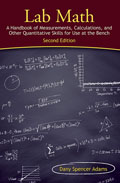This blog, like the book Lab Math from which it springs (incompletely formed), will be about numbers. I will endeavor to:
1. showcase the basic and the practical, not the challenging or even the advanced;
2. provide straightforward guidance for the unenthusiastic (“just do it this way”);
3. provide refreshers for those needing refreshment (whether they know it or not.)
CONTENTS:
>HOW TO CALCULATE. There will be simple rules for doing calculations that are frequently needed in the lab, including that most essential, most misunderstood, (and, sadly, most misused) set of numbers, statistics, (see example quiz above). There will be a lot of overlap between these and Lab Math.
>STATISTICS EXPLAINED. Basic statistical thinking and procedures explained.
>ONLINE CALCULATORS REVIEWED. You will also find reviews of other cites that offer help with math, in one way or another. Want to use an online melting temperature calculator but don’t know which one you can trust? Check here, there may be some useful advice.
>FIGURES REVISITED. When the opportunity arises, I will analyse published figures that I believe could be more enlightening if presented a different way. I reserve the right to go outside the scientific literature for my sources.
>INTERVIEWS WITH MATHEMATICAL MINDS. I will report on conversations with other scientists who not only like numbers, but who are very very good at explaining them. I plan to chat up scientists with good attitudes, good advice, and good stories.
>NUMERICAL OP-ED. Not everything is understood or agreed on. From time to time we may post a request for carefully-thought-out thoughts on subjects that are still under discussion in the real world.
> RANDOM NUMBERS AND TIME SINKS. I expect there will also be some random variation in content as I run across amusing, useful, elegant, or otherwise intriguing number-related things. This may also include some beta testing of interactive features.
Quiz: True, False, or Huh?: Standard error of the mean (s.e.m.) is a descriptive statistic that provides information about the range of values you measured.
If you answered Huh?, this blog is here to guide you.
If you answered True, you are wrong (which is great, because it means you will remember it now), and this blog is here to refresh you.
If you answered False: go ahead and feel superior, and thank your stats teacher. I hope you will enjoy the content here anyway.
Etc, for the interested:
Why it is false: Standard error of the mean (standard error, s.e.m.) is a step along the way to inferring something about the population from which you sampled; it does not describe your sample. It may look good, but you just have to let it go. Because s.e.m. represents a range that varies with sample size, it is not, in fact, standard. Bad name alert. Use s.e.m. to calculate confidence intervals, do not report s.e.m.
What would be true: Standard deviation (s) is a descriptive statistic that provides information about the range of values you actually measured. Importantly, it provides the same information everytime it’s used: it always means about 67% of the actual measurements fell between plus and minus that amount, and about 95% of the measurements fell within twice that. Standard deviation is the standard.
Editorial: It is amazing to me that journals will publish graphs that show the s.e.m. That just forces the reader to find each of the sample sizes, take their square roots, then multiply them by the sizes of the bars. Do you really want to annoy your readers?
Reference: http://www.ncbi.nlm.nih.gov/pubmed/8899234. Maintaining standards: differences between the standard deviation and standard error, and when to use each. DL Streiner.
———
Why and how to contact us:
Is there something numerical you would like to see explained, or a rule you are looking to learn? Email us with the words “please explain” in the subject line.
Is there something wrong here? This link is for reporting demonstrably incorrect facts and figures; disagreement with editorial content will be ignored: Email us with the word “mistakes” in the subject line.
Know a good trick or shortcut or explanation that could help others? Email us with the words “helpful hints” in the subject line.
Want to nominate a figure for re-configuring? Email us with the words “figure” in the subject line.
Send email to: labmathblog@whatever {please put in the correct address}
